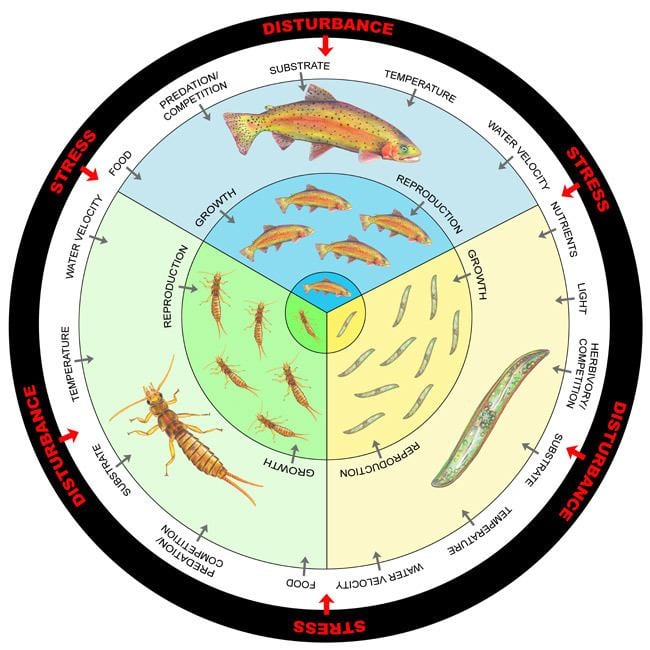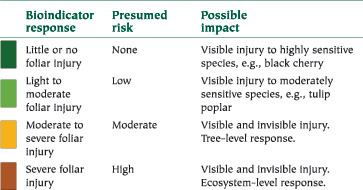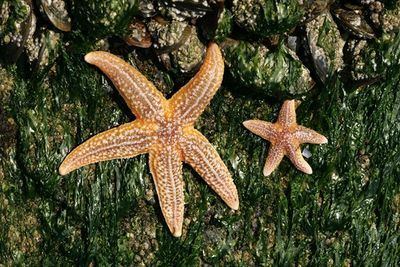 | ||
Representative species Salmon louse, Anchor worm, Calanus finmarchicus, Lernaeocera branchialis, Acartia tonsa | ||
A bioindicator is any biological species (an "indicator species") or group of species whose function, population, or status can reveal the qualitative status of the environment. For example, copepods and other small water crustaceans that are present in many water bodies can be monitored for changes (biochemical, physiological, or behavioural) that may indicate a problem within their ecosystem. Bioindicators can tell us about the cumulative effects of different pollutants in the ecosystem and about how long a problem may have been present, which physical and chemical testing cannot.
Contents
- Overview
- Plant indicators
- Animal indicators and toxins
- Microbial indicators and chemical pollutants
- Microbial indicators in oil and gas exploration
- Microalgae as bio indicators for water quality
- ECOTOX
- Macroinvertebrate bio indicators
- Related journal
- References

A biological monitor, or biomonitor, can be defined as an organism that provides quantitative information on the quality of the environment around it. Therefore, a good biomonitor will indicate the presence of the pollutant and also attempt to provide additional information about the amount and intensity of the exposure.
Overview

A bio indicator is an organism or biological response that reveals the presence of the pollutants by the occurrence of typical symptoms or measurable responses, and is therefore more qualitative. These organisms (or communities of organisms) deliver information on alterations in the environment or the quantity of environmental pollutants by changing in one of the following ways: physiologically, chemically or behaviourally. The information can be deduced through the study of:
- their content of certain elements or compounds
- their morphological or cellular structure
- metabolic-biochemical processes
- behaviour, or
- population structure(s).

The importance and relevance of biomonitors, rather than man-made equipment, is justified by the statement: "There is no better indicator of the status of a species or a system than a species or system itself."
The use of a biomonitor is described as biological monitoring (abbr. biomonitoring) and is the use of the properties of an organism to obtain information on certain aspects of the biosphere. Biomonitoring of air pollutants can be passive or active. Passive methods observe plants growing naturally within the area of interest. Active methods detect the presence of air pollutants by placing test plants of known response and genotype into the study area.
Bioaccumulative indicators are frequently regarded as biomonitors.
Depending on the organism selected and their use, there are several types of bio-indicators.
Plant indicators
The presence or absence of certain plant or other vegetative life in an ecosystem can provide important clues about the health of the environment: environmental preservation.
There are several types of plant and fungi biomonitors, including mosses, lichens, tree bark, bark pockets, tree rings, leaves, and fungi.
There are genetically engineered organisms, that can respond to toxicity levels in the environment; e.g., a type of genetically engineered grass that grows a different colour if there are toxins in the soil.
Animal indicators and toxins
An increase or decrease in an animal population may indicate damage to the ecosystem caused by pollution. For example, if pollution causes the depletion of important food sources, animal species dependent upon these food sources will also be reduced in number: population decline. Overpopulation can be the result of opportunistic species growth. In addition to monitoring the size and number of certain species, other mechanisms of animal indication include monitoring the concentration of toxins in animal tissues, or monitoring the rate at which deformities arise in animal populations, or their behaviour either directly in the field or in a lab.
Microbial indicators and chemical pollutants
Microorganisms can be used as indicators of aquatic or terrestrial ecosystem health. Found in large quantities, microorganisms are easier to sample than other organisms. Some microorganisms will produce new proteins, called stress proteins, when exposed to contaminants such as cadmium and benzene. These stress proteins can be used as an early warning system to detect changes in levels of pollution.
Microbial indicators in oil and gas exploration
Microbial Prospecting for oil and gas (MPOG) is often used to identify prospective areas for oil and gas occurrences. In many cases oil and gas is known to seep toward the surface as a hydrocarbon reservoir will usually leak or have leaked towards the surface through buoyancy forces overcoming sealing pressures. These hydrocarbons can alter the chemical and microbial occurrences found in the near surface soils or can be picked up directly. Techniques used for MPOG include DNA analysis, simple bug counts after culturing a soil sample in a hydrocarbon based medium or by looking at the consumption of hydrocarbon gases in a culture cell.
Microalgae as bio-indicators for water quality
Microalgae have gained attention in the recent years due to several reasons because of their greater sensitivity to pollutants than many other organisms. In addition they occur abundantly in nature, they are an essential component in very many food webs, they are easy to culture and to use in assays and there are few if any ethical issues involved in their use.
Euglena gracilis is a motile freshwater photosynthetic flagellate. Although Euglena is rather tolerant to acidity, it responds rapidly and sensitively to environmental stresses such as heavy metals or inorganic and organic compounds. Typical responses are the inhibition of movement and the change of orientation parameters. Moreover, this organism is very easy to handle and grows, making it a very useful tool for eco-toxicological assessments. One very useful particularity of this organism is the gravitactic orientation, which is very sensitive to pollutants.
The gravireceptors are impaired by pollutants such as heavy metals and organic or inorganic compounds. Therefore, the presence of such substances is associated with random movement of the cells in the water column. For short term tests, gravitactic orientation of E. gracilis is very sensitive. Other species such as Paramecium biaurelia (see Paramecium aurelia) also use gravitactic orientation.
ECOTOX
ECOTOX is an automatic bioassay device used to test the quality of water samples, by the detection of toxic chemicals. It is small piece of hardware containing a miniaturized microscope linked to a camera, an observation cuvette, pumps to mix the water samples with the microalgae; everything being connected to a computer equipped with software. One of the biggest advantages of this device is the automated measurements and analysis, which reduces the risks of personal error. Moreover, it is easy to use, quite cheap and fast: only 10 min are necessary to test a water sample and the corresponding control. Examples of use are the test of seepage water or the determination of the efficiency of purification systems by testing treated waste water before and after purification. The determination of the samples quality is derived from analysis of several parameters related to the movement of the microalgae. All measurements are made automatically with real time image analysis. First the orientation behaviour of the cells is determined using two parameters: the percentage of cells moving upwards giving the direction of the movement and the r-value indicating the precision of the gravitactic orientation which varies from a random movement (r-value=0) to a single direction (r-value=1). Other important parameters are the velocity, the cell motility which represents the percentage of cells moving faster than the minimum velocity and the cell compactness giving information about the shape of the cell. All parameters are compared with a control sample of unpolluted tap water and the percentage of inhibition is calculated. An inhibition indicates the presence of a pollutant. Depending on the aim of the study, the EC50 (the concentration of sample which affects 50 percent of organisms) and the G-value (lowest dilution factor at which no-significant toxic affect can be measured), are calculated. From all those parameters, the gravitactic orientation represented with upward swimming and r-value is the most sensitive.
Macroinvertebrate bio-indicators
Macroinvertebrates are useful and convenient indicators of the ecological health of a water body. They are almost always present, and are easy to sample and identify. The sensitivity of the range of macroinvertebrates found will enable an objective judgement of the ecological condition to be made. Tolerance values are commonly used to assess water pollution.
In Australia, the SIGNAL method has been developed and is used by researchers and community "Waterwatch" groups to monitor water health.
In Europe, a remote online biomonitoring system was designed in 2006. It is based on bivalve molluscs and the exchange of real time data between a remote intelligent device in the field (able to work for more than 1 year without in-situ human intervention) and a data centre designed to capture, process and distribute on the web information derived from the data. The technique relates bivalve behaviour, specifically shell gaping activity, to water quality changes. This technology has been successfully used for the assessment of coastal water quality in various countries (France, Spain, Norway, Russia, Svalbard (Ny Alesund) and New Caledonia).
In the United States, the Environmental Protection Agency (EPA) has published Rapid Bioassessment Protocols, based on macroinvertebrates, as well as periphyton and fish. These protocols are used by many federal, state and local government agencies to design biosurveys for assessment of water quality. Volunteer stream monitoring organizations around the U.S., working in cooperation with government agencies, typically use macroinvertebrate methods. The species identification procedures are conducted in the field without the use of specialized equipment, and the techniques can be easily taught in volunteer training sessions.
In South Africa, the Southern African Scoring System (SASS) method was developed as a rapid bioassessment technique, based on benthic macroinvertebrates, and is used for the assessment of water quality in Southern African rivers. The SASS aquatic biomonitoring tool has been refined over the past 30 years and is now on the fifth version (SASS5) which has been specifically modified in accordance with international standards, namely the ISO/IEC 17025 protocol. The SASS5 method is used by the South African Department of Water Affairs as a standard method for River Health Assessment, which feeds the national River Health Programme and the national Rivers Database.
The imposex phenomenon in the dog conch species of sea snail leads to the abnormal development of a penis in females, but does not cause sterility. Because of this, the species has been suggested as a good indicator of pollution with organic man-made tin compounds in Malaysian ports.
